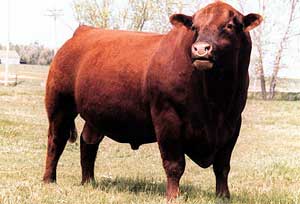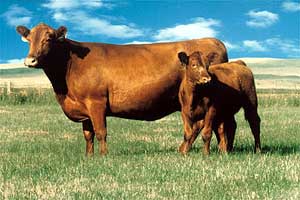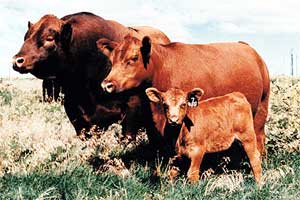Red Angus Cattle
 Seven innovative breeders chose to use Red Angus in 1954 to establish the industry’s
first performance registry. Throughout its history, the Red Angus Association of America
has gone on to make all the tough choices, and all the right choices. In recent years,
the Red Angus breed has attained a high level of popularity from commercial cattlemen,
and for all the right reasons.
Seven innovative breeders chose to use Red Angus in 1954 to establish the industry’s
first performance registry. Throughout its history, the Red Angus Association of America
has gone on to make all the tough choices, and all the right choices. In recent years,
the Red Angus breed has attained a high level of popularity from commercial cattlemen,
and for all the right reasons.
The Origin of "Angus"
Like most modern American beef breeds, the Red Angus breed had its beginning in Europe. In the eighth-century, according to some authorities, hardy Norsemen raiding the coasts of England and Scotland brought with them a small, dun-colored hornless cattle which interbred with black native Celtic cattle of inland Scotland, which had upright horns. A naturally polled black breed was produced, which roughly corresponded to the black Aberdeen Angus of today, although it was a considerably smaller-bodied animal. The polled characteristic was very slow to spread inland, and for almost a thousand years was confined principally to the coastal areas of England and Scotland.
Eric L.C. Pentecost, the noted English breeder of Red Angus cattle, offers a specific and logical explanation for the introduction of the red coloration into the Aberdeen Angus breed. In the eighteenth century, the black Scottish cattle were too light to provide sufficiently large draught oxen, so larger English longhorns, predominantly red in color, were brought in and crossed with the black native polled breed. The resultant offspring were all black polled animals, since black is a dominant color, and red a recessive one. However, all carried the red gene. Subsequent interbreeding produced an average of one red calf in four, in accordance with Mendel’s law of heredity.
Angus - Red or Black
Early in the development of the Aberdeen Angus, Hugh Watson of Keillor, Scotland arbitrarily decided that black was the proper color for the breed, and thereby started a fashion. He might well have chosen red instead. Leon J. Cole and Sara V. H. Jones of the University of Wisconsin Agricultural Experiment Station published a pamphlet in 1920 on "The Occurrence of Red Calves in Black Breeds of Cattle" which contained this pertinent paragraph:
"One more point should be emphasized, namely that the red individuals appearing in such stock (Aberdeen Angus)...are just as truly 'purebred' as their black relatives, and there is no reason why, in all respects save color, they should not be fully as valuable. The fact that they are discarded while the blacks are retained is simply due to the turn of fortune that black rather than red became established fashion for the Aberdeen Angus breed. Had red been the chosen color, there would never have been any trouble with the appearance of blacks as off-color individuals, since red-to-red breeds true."
The preceding paragraph, written more than three decades prior to the establishment of the Red Angus Association of America, shows a true appreciation of the basic strengths of the reds. This is emphasized by the current revival and popularity of the red strain of Aberdeen Angus throughout the world.
Early Angus Herdbooks
 The first Aberdeen Angus herdbook, published in 1862 in Scotland, entered both reds
and blacks without distinction. This practice is continued in Britain today, as is
the case throughout most of the world. Aberdeen Angus was introduced into America
in the 1870s and soon attained high popularity. The first American herd books, published
in 1886 and 1888 respectively, made no record as to the color of individual animals.
In 1890, twenty-two reds were registered in the American Aberdeen Angus Herdbook of
some 2,700 individuals entered that year. Finally, the reds and other colors were
barred from registration altogether after 1917. This severe discrimination against
the red color in an effort to assure a pure black strain brought a marked decline
in the number of red calves born in American herds.
The first Aberdeen Angus herdbook, published in 1862 in Scotland, entered both reds
and blacks without distinction. This practice is continued in Britain today, as is
the case throughout most of the world. Aberdeen Angus was introduced into America
in the 1870s and soon attained high popularity. The first American herd books, published
in 1886 and 1888 respectively, made no record as to the color of individual animals.
In 1890, twenty-two reds were registered in the American Aberdeen Angus Herdbook of
some 2,700 individuals entered that year. Finally, the reds and other colors were
barred from registration altogether after 1917. This severe discrimination against
the red color in an effort to assure a pure black strain brought a marked decline
in the number of red calves born in American herds.
Rebirth of "Red" Angus
Various cattlemen throughout the United States understood the outstanding values of the reds. In 1945, the first of these cattlemen started selecting and breeding reds cropped from the best black Aberdeen Angus herds in America. By 1954, a sufficient number of herds had been established to form a breeder’s organization known as the "Red Angus Association of America."
With a temporary headquarters in Sheridan, Wyoming, seven innovative cattle breeders
created the Red Angus Association as the first performance breed registry in the United
States. In August of 1954, the Association’s first president, Waldo Forbes, Sr., summed-up
this vision of the founding members:
"The policy of the (Red Angus) Association is to discourage the more artificial practices in purebred cattle production... and to place its faith instead in objective tests, consisting for the most part of comparisons within herds of factors of known economic importance and known heritability... By making this an integral part of the registration system, Red Angus breeders feel that even faster progress can be made toward the ultimate goal of more efficient beef production."
From the beginning, performance data was required for registration for all cattle. The ultimate goal was to initiate a system to objectively evaluate and select cattle based on traits of economic importance.
The Red Angus Association of America
The RAAA has long been noted for its farsighted vision of beef production. Over a variety of fronts Red Angus has either led the industry, or been an early adopter of new technologies. This maverick attitude allowed the RAAA to adopt philosophies and technologies that were deemed too risky or unconventional by other associations. Here is a sample of some visionary policies enacted by the RAAA:
A Leader in the Performance Movement
In 1954, when the Association took this bold move to build a "performance registry", the scientific community had not even settled on using 205 days to serve as the age which weaning weights would be adjusted to. Although collecting and turning in weaning weights has become second nature for Red Angus breeders, very few associations require performance data as a criteria for registration even today when the value and necessity of the performance data has been so clearly demonstrated.
A Leader in Open A.I.
Artificial Insemination has proven to be one of the most powerful tools in the beef industry’s genetic progress. However, as this technology became available, most breed associations enforced strict regulations making the technology impractical for many breeders until the 1970’s. However, the RAAA in 1954 set its own course in which A.I. was open and unrestricted within the Red Angus breed.
A Leader in Performance Data in the Showring
In the decade of the nineties, several breeds have started the use of objective data in the showring as an additional tool for the judge, besides the traditional visual appraisal of animals. Red Angus was the first to incorporate performance data in the showring, holding the first "performance" show in 1956. Although Red Angus is not known as a "show" breed, the Association does sponsor a National Show each year. How is it run? You guessed it, the same as in 1956, with the judge being provided all pertinent objective information such as EPDs.
A Leader in the Promotion of Crossbreeding
As early as 1961, the RAAA developed a pamphlet promoting crossbreeding. This was approximately ten years prior to the industry even starting to accept crossbreeding as a tool for commercial cow/calf production. In 1970, Red Angus continued its industry leadership by starting and promoting an F-1 program. 1999 marked another first as the RAAA successfully spearheaded a joint-breed promotion extolling the advantages of heterosis.
A Leader in Offering an Open Registry
In 1980, the RAAA broke ranks from the other British breeds by instituting a category registration system. This far sighted program still kept the 100%, Category 1-A cattle separated, but it additionally allowed breeders to develop purebred, Category 1-B cattle through a process of breeding-up. Furthermore, by instituting a Category II and III, the Association is able to maintain a performance registry for foundation animals and composites.
A Leader in Focusing on Commercial Customers
Red Angus has always prided itself as the first breed that focused its primary attention on customers — the commercial cow/calf producers of the United States. In keeping with this focus, the American Red Angus Magazine is sent to all Red Angus bull customers. The Association also started a Commercial Marketing Program in 1994. Believed to be the second such program in the industry, it offers a wide range of services designed to enhance the profitability of producers utilizing Red Angus genetics in their commercial operations.
A Leader in Total Herd Reporting
In the tradition of being the true "performance breed", the Association again broke ranks with the other breed associations when they implemented an inventory based fee structure and reporting system in 1995. Total Herd Reporting (THR) requires the production of every registered Red Angus female to be accounted for every year, as well as the performance of every Red Angus calf raised through weaning. If a cow and her calf are not accounted for in a given year, the cow is removed from the registry.
A Leader in Evaluating Fertility
The RAAA has led the industry with its commitment to objectively describing traits related to reproduction and sustained fertility. The first of this new class of EPDs was Red Angus’ Stayability estimate. This EPD ranks animals with regard to the probability their daughters will continue producing in the herd past six years of age. The development of a new Heifer Pregnancy EPD expands Red Angus’ commitment in this vital area.
A Leader in Genotypic Certification
In 1995, Red Angus unveiled the industry’s first genotypic and source identified program, the Feeder Calf Certification Program (FCCP). The innovative FCCP has the honor of being the first program of its kind to be USDA Process Verified, certifying a calf’s link to the "Angus" gene pool.
A Leader in Value Based Marketing
Red Angus has been at the forefront of the industry’s efforts to move toward a system of value based marketing. The Association is believed to be the first breed association to offer its members and commercial customers a value-based pricing grid with a major packing company.
Leadership Has Made A Difference
Red Angus are Angus; yet the Red Angus breeders’ history of leadership and innovation have made a profound difference in the red strain. They have avoided the short-term fads that have negatively affected so many other breeds. Coupled with the long-term commercial focus of the membership, the Red Angus gene pool also offers many advantages. Red Angus provides a consistent source of traditional Angus traits, including carcass quality, maternal characteristics, calving ease, and moderate size. In addition, Red Angus offer uniformity, good disposition, and an outstanding appetite.
Today, Red Angus are seeing unparalleled popularity both in the U.S. and internationally. In fact, the growing notoriety of the breed is bringing worldwide demand for breeding stock from South Africa, Australia and South America, where the majority of the cattle are red in color. This has led Red Angus to become the leading U.S. beef breed in semen exports. In the U.S., the number of Red Angus has tripled from the mid-1980’s through the mid-1990’s. In Canada, where red and black Angus cattle are registered together (which is the case in most countries), the number of red cattle registered is approximately the same as the black strain.
The Future
Due to the numerous natural advantages with which the Red Angus breed is endowed, and based off the heritage and continued philosophy of the Red Angus Association of America, it appears that a great breed is coming into its own. The future of the breed as the common denominator in progressive cattle producers’ crossbreeding systems is unlimited. As Joseph Givhan, founding RAAA member, shared in his early publication on the breed’s history...
"Here is a noble breed that will never die, destined to increase and flourish. It shall cover the grazing lands of the earth and forever enrich the husbandry of mankind."
References
Red Angus Association of America, 4201 I-35 North, Denton, Texas 76207-7443, Phone: (940) 387-3502
